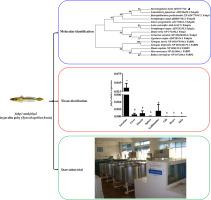Comparative Biochemistry and Physiology B: Biochemistry & Molecular Biology ( IF 1.9 ) Pub Date : 2020-08-01 , DOI: 10.1016/j.cbpb.2020.110484 Xiangning Chen 1 , Yingli Gao 1 , Guanju Wu 2 , Jiaze Gu 2 , Yuefeng Cai 2 , Jianhe Xu 2 , Hanliang Cheng 2

|
Fatty acid binding proteins (FABPs) are intracellular lipid chaperones with low molecular weight, which are widely distributed in a variety of tissues, participating in fatty acid transport, cell proliferation, and angiogenesis. In this study, full-length sequences of two fabp genes (fabp1 and fabp2) from javelin goby (Synechogobius hasta) were cloned via RACE PCR, followed by bioinformatic analyses and gene expression evaluation. The fabp1 and fabp2 cDNA sequences were 493 and 626 bp in length, encoding 126 and 132 amino acids, respectively. Phylogenetic analysis revealed that both genes from S. hasta were clustered with those of other fish species in accordance with their known taxonomic relationships. fabp1 and fabp2 mRNA showed distinct expression patterns in different tissues, with fabp1 being most expressed in the liver and fabp2 in the intestine. Furthermore, the expression of fabp1 in the liver was significantly up-regulated during starvation, whereas fabp2 mRNA level in the intestine initially increased and then decreased, indicating that the transcriptional responses of the two genes could be influenced by malnourishment/starvation. Changes in the transcriptional levels of fabp1 and fabp2 also suggested that glycogen was catabolized in the liver of S. hasta at the beginning of starvation prior to lipid depletion, whereas lipids served as fuel reserves in the intestine during short-term starvation. In conclusion, this study provides fundamental insights into the role of Fabps in S. hasta lipid metabolism.
中文翻译:

标枪虾虎鱼(Synechogobius hasta)中fabp1和fabp2的分子克隆,组织表达和转录调控,响应饥饿压力。
脂肪酸结合蛋白(FABP)是低分子量的细胞内脂质分子伴侣,广泛分布在各种组织中,参与脂肪酸转运,细胞增殖和血管生成。在这项研究中,通过RACE PCR克隆了标枪虾虎鱼(Synechogobius hasta)的两个fabp基因(fabp1和fabp2)的全长序列,然后进行了生物信息学分析和基因表达评估。的FABP1和FABP2 cDNA序列分别为493和626个碱基的长度,分别编码126和132个氨基酸。系统发育分析表明,这两个基因都来自哈氏链球菌。根据其已知的分类学关系将它们与其他鱼类的聚类在一起。fabp1和fabp2 mRNA在不同组织中显示出不同的表达模式,其中fabp1在肝脏中表达最多,而fabp2在肠道中表达最多。此外,饥饿期间肝脏中fabp1的表达显着上调,而肠道中fabp2 mRNA的水平先升高后降低,表明营养不良/饥饿可能影响这两个基因的转录反应。fabp1和fabp2转录水平的变化也有人认为糖原分解代谢中的肝S.闪现之前脂质枯竭饿死的开始,而脂类短期饥饿期间担任在肠道燃料储备。总之,这项研究提供了对Fabps在S. hasta脂质代谢中的作用的基本见解。











































 京公网安备 11010802027423号
京公网安备 11010802027423号